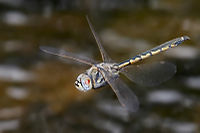
Photo from wikipedia
Many tropical fruit-feeding nymphalid butterflies are associated with either the forest canopy or the understorey; however, the exceptions offer insights into the origins of tropical diversity. As it occurs in… Click to show full abstract
Many tropical fruit-feeding nymphalid butterflies are associated with either the forest canopy or the understorey; however, the exceptions offer insights into the origins of tropical diversity. As it occurs in both habitats of tropical forests in Ecuador and Peru, Archaeoprepona demophon is one such exception. We compared patterns of occurrence of A. demophon in the canopy and understorey and population genomic variation for evidence of ecological and genetic differentiation between habitats. We found that butterfly occurrences in the canopy were largely uncorrelated with occurrences in the understorey at both localities, indicating independent demographic patterns in the two habitats. We also documented modest, significant genome-level differentiation at both localities. Genetic differentiation between habitat types (separated by approx. 20 m in elevation) was comparable to levels of differentiation between sampling locations (approx. 1500 km). We conclude that canopy and understorey populations of A. demophon represent incipient independent evolutionary units. These findings support the hypothesis that divergence between canopy and understorey-associated populations might be a mechanism generating insect diversity in the tropics.
Journal Title: Biology Letters
Year Published: 2019
Link to full text (if available)
Share on Social Media: Sign Up to like & get
recommendations!